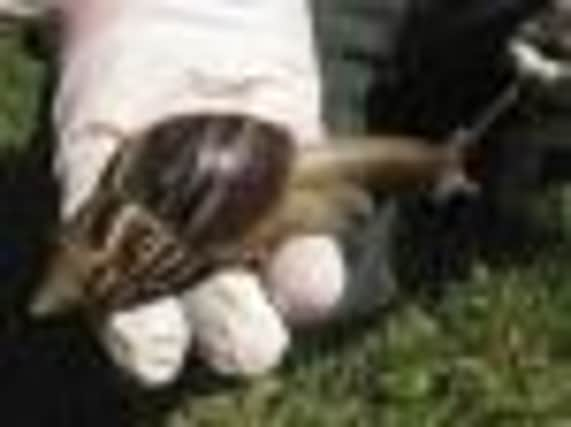Florida sees giant African land snail infestation


More than 1,000 of the molluscs are being caught each week in Miami-Dade and 117,000 in total since the first snail was spotted by a homeowner in September 2011, said Denise Feiber, a spokeswoman for the Florida Department of Agriculture and Consumer Services.
Residents will soon likely begin encountering them more often, crunching them underfoot as the snails emerge from underground hibernation at the start of the state’s rainy season in just seven weeks, Ms Feiber said this weekend.
Advertisement
Hide AdAdvertisement
Hide AdThe snails attack “over 500 known species of plants ... pretty much anything that’s in their path and green,” she said.
In some Caribbean countries, such as Barbados, which are overrun with the creatures, the snails’ shells blow out tires on the highway and turn into daunting projectiles from lawnmower blades, while their slime and excrement coat walls and pavement.
A typical snail can produce about 1,200 eggs a year and the creatures are a particular pest in homes because of their fondness for stucco, devoured for the calcium content they need for their shells.
The snails also carry a parasitic rat lungworm that can cause illness in humans, including a form of meningitis.
The snails’ saga is something of a sequel to the Florida horror show of exotic species invasions, including the giant Burmese pythons, which became established in the Everglades in 2000.
Experts gathered last week in Gainesville, Florida, for a giant African land snail science symposium, to seek the best ways to eradicate the pest.
Ms Feiber said investigators were trying to trace the snail infestation source. One possibility being examined is a Miami Santeria group, a religion with West African and Caribbean roots, which was found in 2010 to be using the large snails in its rituals, she said. But many exotic species come into the US unintentionally in freight or tourists’ baggage.
“If you got a ham sandwich in Jamaica or the Dominican Republic, or an orange, and you didn’t eat it all and you bring it back into the States and then you discard it, at some point, things can emerge from those products,” Ms Feiber said.
Advertisement
Hide AdAdvertisement
Hide AdAuthorities are advertising the problem and urging the public to be on the lookout.
The last known Florida invasion of the giant molluscs occurred in 1966, when a boy returning to Miami from a vacation in Hawaii brought back three of them.
His grandmother eventually released the snails into her garden where the population grew in seven years to 17,000. The state spent $1 million and ten years eradicating them.
Ms Feiber said many people unfamiliar with the danger viewed the snails as cute pets.
“They’re huge, they move around, they look like they’re looking at you ... communicating with you, and people enjoy them for that,” Ms Feiber said. “But they don’t realise the devastation they can create if they are released into the environment.”